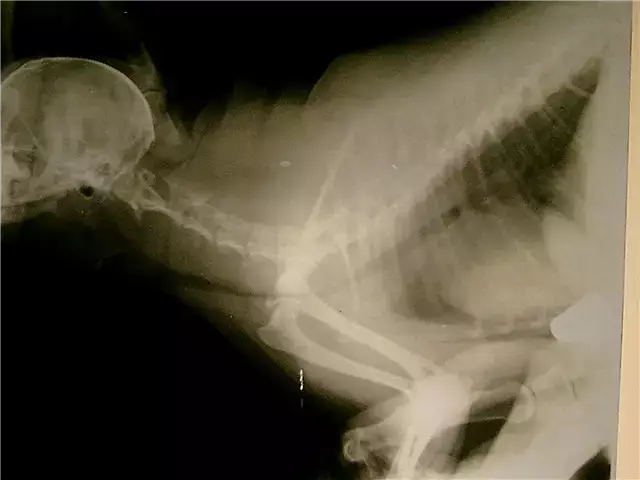Dyclogen
Instructions for use:
- 1. Release form and composition
- 2. Indications for use
- 3. Contraindications
- 4. Method of application and dosage
- 5. Side effects
- 6. Special instructions
- 7. Drug interactions
- 8. Analogs
- 9. Terms and conditions of storage
- 10. Terms of dispensing from pharmacies
Prices in online pharmacies:
from 22 rubles.
Buy

Dyclogen is a non-steroidal anti-inflammatory drug (NSAID) with analgesic and antipyretic effects.
Release form and composition
- Gel for external use 1% and 5%: almost white, translucent, with a specific odor (30 and 50 g each in aluminum tubes, 1 tube in a cardboard box);
- Enteric-coated tablets: round, biconvex, light brown, with beveled edges (10 pcs. In blisters or blisters, in a cardboard box 5 blisters or packages);
- Sustained-release enteric-coated tablets: round, biconvex, pink, with beveled edges (10 pcs. In contoured non-cell packs, 2 packs in a cardboard box);
- Solution for intramuscular and intravenous administration: transparent, from colorless to yellowish color (3 ml in ampoules: 5 ampoules in contour plastic packs, in a cardboard box 1 or 2 packs; 10 ampoules in contour plastic packs, in a cardboard box 1 pack).
The active substance of Diclogen is diclofenac sodium:
- 1 g of gel - 10 or 50 mg;
- 1 enteric coated tablet - 50 mg;
- 1 extended-release tablet - 100 mg;
- 1 ml solution for injection - 25 mg.
Excipients:
- Gel: liquid paraffin, isopropanol, trolamine, disodium edetate, carbomer, chlorocresol, polysorbate 80, propylene glycol, benzyl alcohol, sodium sulfite, purified water, lavender oil;
- Enteric-coated tablets: corn starch, povidone, calcium dihydrogen phosphate, sodium starch glycolate, lactose, isopropyl alcohol, purified talc, methylene chloride, magnesium stearate, yellow dye (Opadry Yellow mix / OY-P-5290);
- Extended-release enteric-coated tablets: hydroxypropyl methylcellulose, guar gum, povidone, isopropyl alcohol, magnesium stearate, purified talc, dextrose. Shell composition: hydroxypropyl methylcellulose, titanium dioxide, propylene glycol, isopropyl alcohol, purified talc, ethyl cellulose, methylene chloride, iron oxide red;
- Solution for injection: sodium sulfite anhydrous, benzyl alcohol, mannitol, hydrochloric acid, propylene glycol, water for injection.
Indications for use
Gel for external use
- Pain syndrome and swelling caused by diseases of muscles and joints: radiculitis, osteoarthritis, sciatica, lumbago, rheumatoid arthritis and muscle pain, including rheumatic origin;
- Rheumatic diseases of soft tissues: bursitis, tendovaginitis, damage to periarticular tissues;
- Post-traumatic inflammation of soft tissues and joints (for example, due to bruises, overexertion and sprains).
Tablets and solution for injection
- Pain syndrome and swelling caused by diseases of muscles and joints: myalgia, neuralgia, lumbago, sciatica;
- Inflammatory diseases of the periarticular tissues: bursitis, tendovaginitis, rheumatic lesions of soft tissues;
- Degenerative diseases of the musculoskeletal system: osteochondrosis, deforming osteoarthritis;
- Inflammatory diseases of the musculoskeletal system: ankylosing spondylitis, gout, arthritis (rheumatoid, juvenile, psoriatic, gouty);
- Post-traumatic pain syndrome with inflammation, postoperative pain;
- Renal / hepatic colic;
- Migraine;
- Adnexitis, proctitis, primary algodismenorrhea;
- Complex therapy of infectious and inflammatory diseases of the upper respiratory tract, accompanied by severe pain syndrome: otitis media, tonsillitis, pharyngitis.
Contraindications
For all dosage forms:
- History of aspirin asthma (an attack of bronchial obstruction, rhinitis and urticaria after taking acetylsalicylic acid or other NSAIDs);
- Pregnancy and lactation;
- Individual hypersensitivity to drug components or other NSAIDs.
Additionally for the gel:
- Violation of the integrity of the skin;
- Children under 6 years old;
- III trimester of pregnancy.
Additionally for tablets and solution for injection:
- Erosive and ulcerative lesions of the gastrointestinal tract in the acute phase;
- Hematopoietic disorders;
- Children under 6 years of age - for coated tablets, up to 18 years - for extended-release tablets and solution for injections;
- Pregnancy and lactation.
Diclogen should be used with caution in the following cases:
- Gel: severe liver and / or kidney dysfunction, exacerbation of hepatic porphyria, erosive and ulcerative lesions of the gastrointestinal tract, bronchial asthma, chronic heart failure, bleeding disorders (including a tendency to bleed, prolonged bleeding time, hemophilia), I and II trimesters of pregnancy, advanced age;
- Tablets: heart failure, severe liver and / or kidney dysfunction, induced acute hepatic porphyria, as well as elderly patients and patients who, for any reason, have a decrease in the volume of circulating fluid (for example, after extensive surgery);
- Solution for injection: heart failure, severe liver and / or kidney dysfunction.
Method of administration and dosage
Gel for external use
In the form of a gel, Diclogen is applied externally, gently rubbing in, 2 times a day.
The required amount of the drug depends on the size of the painful area. The maximum permissible single doses: children over 12 years old and adults - 2 g, children 6-12 years old - 1 g.
The duration of treatment is determined individually, depending on the indications and the effectiveness of the therapy. After 2 weeks of using the drug, you should consult your doctor.
Enteric-coated tablets
Diclogen should be taken by mouth by swallowing the tablets whole and drinking plenty of water. To quickly achieve a therapeutic effect, it is recommended to take the drug 30 minutes before meals, in other cases - during or after meals.
Adults are prescribed 1 tablet 2-3 times a day. After achieving the optimal therapeutic effect, the dose is gradually reduced and the patient is transferred to maintenance therapy in a daily dose of 50 mg (1 tablet).
Children over 12 years of age are prescribed no more than 2 mg / kg of body weight. In juvenile rheumatoid arthritis, the dose may be increased to 3 mg / kg.
Extended-release tablets
Diclogen should be taken by mouth by swallowing the tablets whole and drinking plenty of water. To quickly achieve a therapeutic effect, it is recommended to take the drug 30 minutes before meals, in other cases - regardless of meals.
Doses are selected individually, depending on the type and severity of the disease.
Adults are usually prescribed 1 tablet (100 mg) 1 time per day. The duration of treatment is determined by the doctor.
Solution for intramuscular and intravenous administration
The drug is administered intravenously in a drip method in a daily dose of not more than 150 mg. Immediately before administration, the contents of 1 ampoule of Diclogen are diluted with 100-500 ml of glucose solution 5% or sodium chloride solution 0.9%, after adding 1 ml of 4.2% or 0.5 ml of 8.4% solution to the infusion solutions of sodium bicarbonate. The duration of the infusion, depending on the severity of the pain syndrome, can be from 30 to 180 minutes. The drug can be administered intravenously for no more than 2 days.
To prevent postoperative pain, Diclogen is infused in a "shock" dose of 25-50 mg for 15-60 minutes, then the administration is continued at a rate of 5 mg / hour until the maximum permissible daily dose of 150 mg is reached.
For relief of pain syndrome caused by exacerbation of chronic diseases, and for the treatment of acute conditions, the drug can be administered intramuscularly 1-2 times, after which the patient can be transferred to the oral form of Diclogen (the total daily dose should not exceed 150 mg). The solution is injected deeply intramuscularly for no more than 2 days.
Side effects
When using Diclogen in gel form:
- Local reactions: photosensitization, eczema, contact dermatitis (papules, swelling of the treated skin area, vesicles, redness, peeling, itching);
- Systemic reactions: photosensitivity, generalized skin rash, allergic reactions (urticaria, bronchospastic reactions, angioedema).
When using Diclogen in the form of tablets and solution for injection:
- Digestive system: anorexia, flatulence, nausea, vomiting, gastralgia, abdominal pain, diarrhea, constipation, gastrointestinal bleeding (melena, hematemesis), increased activity of hepatic transaminases, dry mouth, glossitis, aphthous stomatitis, erosive and ulcerative lesions of gastrointestinal intestinal tract, pancreatitis, hepatitis (including jaundice), non-specific colitis with bleeding, fulminant hepatitis;
- Nervous system: decreased memory, hearing and visual acuity, tinnitus, diplopia, impaired perception, dizziness, disorientation, headache, anxiety, insomnia, paresthesia, irritability, increased fatigue, psychotic reactions, tremors, impaired taste, scotoma, nightmares, depression, convulsions, aseptic meningitis;
- Hematopoietic organs: hemolytic and aplastic anemia, leukopenia, thrombocytopenia, agranulocytosis;
- Cardiovascular system: chest pain, palpitations, increased blood pressure, arrhythmias;
- Urinary system: papillary necrosis, nephrotic syndrome, oliguria, proteinuria, hematuria, cystitis, interstitial nephritis, acute renal failure;
- Skin: photosensitization, alopecia, skin rash (mainly urticaria and erythematous), pruritus, eczema, erythroderma, allergic purpura, angioedema, toxic epidermal necrolysis, exudative erythema multiforme;
- Others: systemic anaphylactic reactions (including shock), edema, bronchospasm, impotence.
special instructions
Diclogen gel should be applied only to intact skin areas, avoiding contact with open wounds. Do not use an occlusive dressing. Wash hands thoroughly after application. Avoid contact with eyes and mucous membranes.
When prescribing the drug in the form of tablets and a solution for injection for the elderly (especially those receiving diuretics), patients with renal or heart failure, as well as patients who have a decrease in the volume of circulating fluid, it is necessary to monitor kidney function. Patients with hepatic insufficiency during long-term therapy require monitoring of the picture of peripheral blood and liver function, performing fecal occult blood tests.
When treating with Diclogen in the form of tablets or solution for injection, it is necessary to refrain from driving and engaging in potentially hazardous activities that require a high reaction rate and increased attention.
Drug interactions
Gel for external use
Diclogen can enhance the action of photosensitizing drugs.
There is no information on clinically significant interactions with other drugs.
Tablets and solution for injection
- Lithium preparations, cyclosporin, digoxin: their concentration in plasma increases;
- Potassium-sparing diuretics: the risk of hyperkalemia increases;
- Diuretics, hypnotics and antihypertensive drugs: their effectiveness decreases;
- Anticoagulants, thrombolytic agents (streptokinase, alteplase, urokinase): the risk of bleeding increases;
- Acetylsalicylic acid: the concentration of diclofenac in the blood decreases;
- Methotrexate: its toxicity increases;
- Other NSAIDs, glucocorticosteroids: increases the likelihood of side effects, including gastrointestinal bleeding;
- Oral antidiabetic drugs: the risk of developing hyper- or hypoglycemia increases;
- Cyclosporine: its nephrotoxicity increases;
- Valproic acid, cefoperazone, plikamycin, cefamandol, cefotetan: the incidence of hypoprothrombinemia increases;
- Gold preparations, cyclosporine, paracetamol: the nephrotoxicity of Diclogen increases;
- Glucocorticosteroids, corticotropin, St. John's wort preparations, colchicine, alcohol: the risk of gastrointestinal complications accompanied by bleeding increases;
- Vasodilators: their hypotensive activity decreases.
Analogs
Diclofenac analogs are: Diclofenac, Diclofenac-Akos, Diclofenac Retard, Diklak, Diklovit, Voltaren, Voltaren Emulgel, Ortofen.
Terms and conditions of storage
Store in a dark, dry place out of reach of children at temperatures up to 25 ºС. Do not freeze.
The shelf life is 3 years.
Terms of dispensing from pharmacies
The tablets and solution are available with a prescription, and the gel is available without a prescription.
Diclogen: prices in online pharmacies
|
Drug name Price Pharmacy |
|
Diclogen 25 mg / ml solution for intramuscular administration 3 ml 5 pcs. 22 RUB Buy |
|
Diclogen 1% gel for external use 30 g 1 pc. RUB 39 Buy |
|
Diclogen 1% gel for external use 50 g 1 pc. RUB 62 Buy |
|
Diclogen 5% gel for external use 30 g 1 pc. 84 rbl. Buy |
|
Diclogen plus gel for external use 30 g 1 pc. 168 RUB Buy |
|
Diclogen plus gel for external use 50 g 1 pc. 198 RUB Buy |
Information about the drug is generalized, provided for informational purposes only and does not replace the official instructions. Self-medication is hazardous to health!







